 Using Color to See More - Looks Can Be Deceiving The Caves of Mars | Education Resources | MER Color Index | |
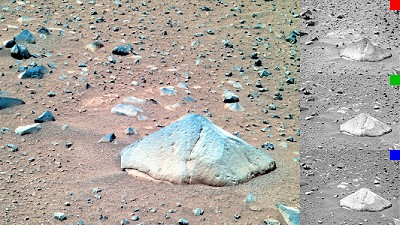 Red green & blue images of Adirondak combined as-is |
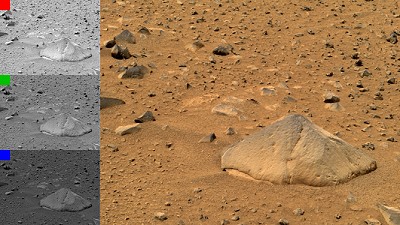 Processed Adirondak shot from Spirit released by JPL |
| To create color pictures from the surface of Mars seems straight forward enough. Take three black and white images shot through red, green and blue filters, combine them, and you have color. Sounds simple enough. Find three images from the MER site, taken through left PanCam filters 4, 5 and 6 (red, green & blue), combine them in a photo imaging program like PhotoShop, and you get color! But is it the correct color? In the image above left of the rock known as "Adirondak" from the Spirit rover site, we did just that. The result is rocks with a decidedly blue look to them! The same image, released as color by the MER Imaging team looks like we would expect it to look: A ruddy, rusty red. Is NASA lying about the "true color" of Mars? After all, images of the Calibration Target "Sun Dial" when done the same way produces seemingly true colors. We asked Don Davis of the International Association of Astronomical Artists about the "blues." He relayed our question to the MER Imaging team at JPL. Here's what they said: "We target the exposure times to give every image roughly the same average density value, regardless of filter. So because of that, it's dangerous to just blindly use the raw images for an RGB composite. The reason it works for some scenes, like the calibration target or spacecraft parts, is that if there is enough 'gray' stuff in the scene (metallic spacecraft parts, for example) then that is what sets the exposure time. When looking at Mars, though, which is quite red, the blue and green exposure times are significantly longer and so the resulting 'raw' RGB composite will look way too blue. Cool, but still 'too blue.' At the very least they should scale the values by the exposure times." With this information, we decided to try our hand at making blue rocks. The image pairs below are the result. On the left, is the scene shot in color, with its red, green and blue channels displayed next to it. The right images were composites created by shooting three individual black and white images through red, green and blue filters. Each of these shots were averaged, so that the exposures of the scenes have about the same approximate density. The result is that the "ground" in each shot, pretty much has the same shade of gray, in this case two types of volcanic cinders. As you can see by our results, we actually got several different colors of rocks! | |
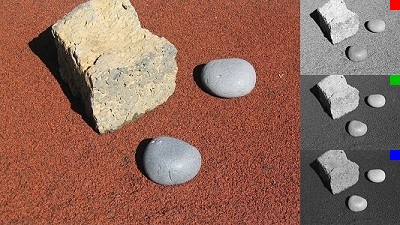 Bright Sun with Red Volcanic Cinders from Central Oregon |
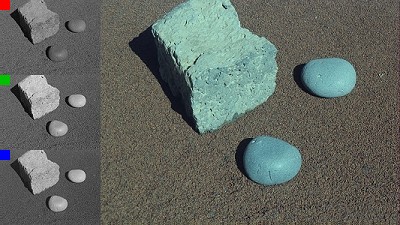 Red Green & Blue Images Combined - Turquoise Rocks! |
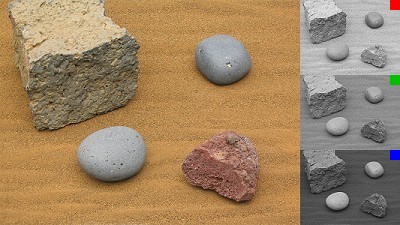 Slightly Overcast, with JSC Mars-1 Soil Simulant & Red Rock |
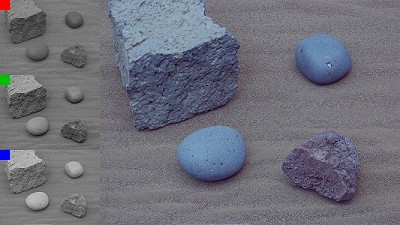 Red Green & Blue Images Combined - Blue Rocks! |
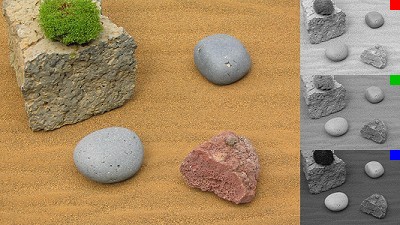 Slightly Overcast, with Oregon Moss Added |
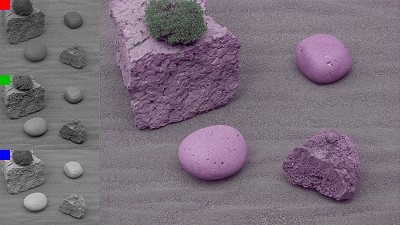 Red Green & Blue Images Combined - Purple Rocks! |
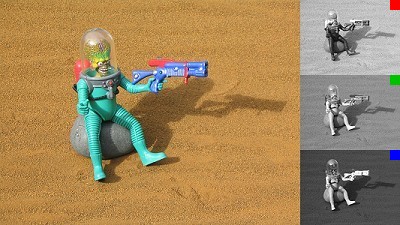 Cloudy Bright with Martian & Blue Blaster Added |
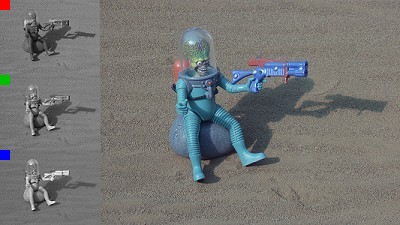 Red Green & Blue Images Combined |
| But why does this happen? It boils down to absorption and reflectance. Click Here for the explanation.
All Images Courtesy NASA/JPL Mars Exploration Rover Mission The Caves of Mars Project is funded by a NIAC Phase II Grant from the NASA Institute for Advanced Concepts. Copyright © 2002-04 - Complex Systems Research; Inc. | |